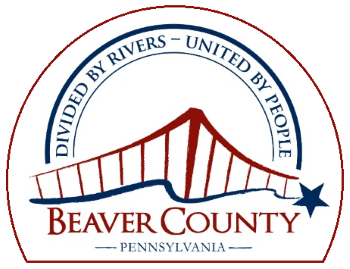History Of Beaver County
Beaver County Pennsylvania is located in the southwest part of the state, and was carved out of Washington and Allegheny Counties in 1800. The county borders Lawrence County on the north, Butler County on the east, Allegheny County on the southeast, Washington County on the south, and the states of Ohio and West Virginia on the west.
A law was passed in 1792 that opened the territory north and west of the Ohio River to occupancy by settlers, but hostilities with the Native Americans limited settlement until General Wayne's Treaty of Greenville in 1795.
Located within the boundaries of the future Beaver County was Logstown, situated on the Ohio River and a busy center of the Indian trade with the French and English in the mid - 1700's. Logstown was also the original site of the Harmony Society's village of Economy. George Washington visited this area at various times to survey the French forts and the general Ohio River area
The townships and boroughs in Beaver County have changed frequently in the county's early years. Beaver County originally had six townships, split by the Ohio River. These townships were Sewickley, South Beaver and North Beaver Townships in the north half of the county, and Hanover, First Moon and Second Moon Townships south of the Ohio River. In 1814 the southern townships were reorganized into four approximately equal quarters and given the names Hopewell, Moon, Green and Hanover Townships. The northern townships had a much more complicated history of division. Sewickley Township divided in 1801 (only one year after the establishment of Beaver County) into North Sewickley and New Sewickley Townships. South Beaver Township experienced several divisions to satisfy residents' complaints that the township was too large. South Beaver Township was first divided in 1802 into three townships: Little Beaver, Big Beaver, and South Beaver Townships. In 1804, the small area in the southeast corner of South Beaver Township, known as Beaver Borough, broke off and became Borough Township. It retained this name until 1970, when it was renamed Vanport Township. In 1805, what was left of South Beaver Township split into Ohio and South Beaver Townships. In 1816, the townships of Ohio and South Beaver were reorganized into four equivalent quarters: Ohio and Brighton Townships just north of the Ohio River, and South Beaver and Chippewa Townships further north.
The town of Beaver, located in Beaver Borough, is the County Seat. Beaver was chosen because it had already been laid out by surveyor Daniel Leet eight years before the establishment of the county. Beaver, Originally the site of Fort McIntosh, was considered a prime location for a town because of its location at the confluence of the Beaver and Ohio Rivers.
The entire area was considered desirable for farming, and the rivers supplied a source of transportation. As water transportation methods improved, small towns began to spring up along the county's many rivers and creeks.
Several natural rapids and falls along the waterways proved useful as waterpower for mills and factories. During the 1830's the area became distinguished for the quality and quantity of its natural resources including limestone, fire clay, sandstone, and coal. Beaver County had a considerable supply of channel coal, a bituminous coal popular for its light compactness and its clean bright flame that lit "as easily as wood."
Despite a steady increase in commercial industry, the county's population was slow to grow for its first fifty years. The sluggish growth rate stemmed from the large number of lawsuits over land titles between settlers claiming title under purchase from the State, and those claiming title under the 1792 clause of "settlement and improvement." Further confusion and lawsuits arose over the Depreciation Lands, land north of the Ohio River. These lands were given as grants to veterans of the American Revolution to compensate for the devaluation of currency used to pay soldiers during the war. Some veterans sold their shares to land companies such as the Pennsylvania Population Company, which had many legal battles with squatters. Also contributing to the slow growth of the county were an adverse series of events in the 1840s, beginning with a general depression partially because of a bank failure at New Brighton, Pennsylvania, the banking center for the county. Other businesses suffered after Pittsburgh's great fire of 1845 since Pittsburgh served as Beaver County's main economic link to other markets. In 1849, an Act of the Legislature took part of Beaver County to form Lawrence County, resulting in a shift of over 9,000 residents to Lawrence County. With the advent of the railroad in Beaver County population and business grew rapidly in the 1850s.
Beaver County was the home of many notable citizens, whose names appear in the county's records. James Allison, called "the honest lawyer", was a district attorney and served a term in the United States Congress. Allison was also a successful merchant and one of the original trustees and first President of Beaver Academy. Thomas Henry was the publisher of the county's first newspaper, the Argus. Brothers Evan and John Pugh owned a variety of businesses, including grist and linseed oil mills, a carding and cloth-dressing factory, and a grocery store. James Lyon was a store owner for 35 years, and served as a county sheriff from 1818-1821. Daniel Agnew was another noted lawyer who eventually rose to Chief Justice of the Supreme Court of Pennsylvania. In the 1820s, the Harmony Society built the community of Economy along the banks of the Ohio River to serve as their religious commune. They brought a sizable increase in the population and business of the county.
